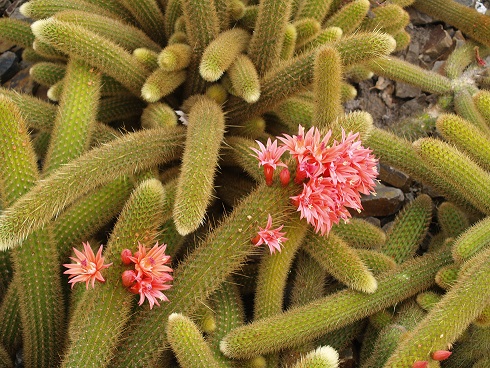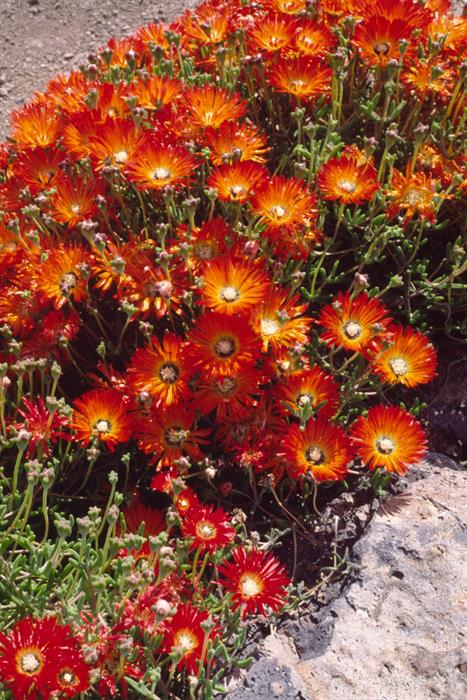Learn to identify and grow a wide variety of different cacti and succulents
Cacti and succulents both include plants that tolerate harsh, dry conditions, but they are two very different groups of plants. Only cacti predominantly come from very dry areas. Some succulents are native to deserts and others are not.
Most cacti need to be treated relatively similarly. Good drainage or at least relative dryness in the root zone is important. If there is too much moisture cacti can easily rot. The way you treat a succulent plant is different from place to place though and according to what you are trying to get from the plant.
- Learn to identify and grow a wide variety of different cacti and succulents
- Create hardy gardens with a completely different aesthetic
- Grow them as decorative container plants, inside or out
- Use them for roof gardens or green walls

COURSE CONTENT
This course is divided into eight lessons as follows:
1. Introduction
- Review of the system of plant identification
- Physiology
- Information sources
- Three Cacti tribes -Perskia, Opuntia, Cerus
- Main succulent genera
- Pronouncing Names
2. Culture
- Planting
- Staking
- Mulching
- Soils
- Feeding
- Pruning etc.
- Propagation
- Methods of propagating cacti & succulent plants
- Propagation of selected varieties
- Seed, Cuttings, Grafting
3. Using Cacti & Succulents
- Edible succulents
- Garden Design
- Garden Styles
- Mexican gardens
- Using Colour
- Rock Gardens
- Growing Cacti or Succulents in containers
4. Culture
- Pests and Disease
- Irrigation
- Greenhouse growing
5. Cacti developing your plant knowledge.
- General guidelines for growing cacti
- Review of Cacti Genera
- Zygocactus -featured plant
6. Succulents developing your plant knowledge.
- Review of Succulent Families
- Bromeliads -featured plants
- Kalanchoe
- Sansavieria
7. Special Project
- PBL - Plan the establishment of a collection of different cultivars of either Cacti OR Succulents suited to growing in a specified locality.
Course Duration - 100 hours
 Learn how Cacti and Succulents are Extremely Variable
Learn how Cacti and Succulents are Extremely Variable
Some species are super hardy and can grow with little attention in poor soils and varied climates. Others require more attention to do well.
Growing cacti and succulents can be rewarding, but the correct conditions must be created to produce the most satisfying growth. Succulents are frequently easy to grow, but it can be harder to grow superb specimens. The main requirements of cacti and succulents is strong light, adequate drainage, and to be sufficiently dry during any dormant period. Cacti and succulents are forgiving plants, and while they respond to the creation of comfortable conditions (such as adequate fertilisation and irrigation), they can frequently produce more pleasing colours or shapes if they are exposed to some stress. Potting media that are low in available nutrients and are freely draining can contribute to the creation of these conditions.
LEARN WHERE TO GROW SUCCULENTS
If you choose an appropriate species, succulents can be used in most garden situations. They are often grown predominantly with other succulents, as a “succulent” area in a garden, but can be used just as much, mixed in with non-succulent plants e.g. plants such as Sedums work well and are often used with other plants in garden borders.
If you grow succulents with other plants, cater to the needs of the other plants more than the needs of the succulents. Succulents can generally adapt to a wider range of conditions than other plants they grow alongside.
Succulents in Exposed Conditions
Low growing succulents with compact growth and thick leaves tend to withstand the drying effects of strong wind and hot sun, more than taller more open shrubs, trees and herbaceous plants.
Succulents in Shade
Many types of plants are often difficult to grow under trees, because the tree roots compete with the roots of shrubs or other plants grown there. Succulents may be affected more by a lack of light in shaded areas, than by any lack of nutrition or water. It all depends upon how shaded it is and the type of succulent you are growing. Many succulents have less of a problem because they have shallow roots, only feeding from the very top of the soil and they have the ability to withstand long dry periods. Some species of Agave, Aeonium, Aloe, Crassula, Haworthia, Sanseveria, and Sedum, amongst others, will grow in shade or part shade.
Succulents on Poor Soils
When the depth of soil is shallow, succulents can often still grow easily. Some are epiphytic or semi epiphytic, and can grow on the surface of rock, wood or masonry; others will survive on a thin layer of soil sitting above stone, or on relatively infertile sand (e.g. sand dunes on a foreshore or desert). The small amount of nutrition that comes from dust brown into an area, or the occasional dead and decomposing insect, may be sufficient to feed some succulents.
Soils that are subject to erosion (e.g. wind or flood), can be held together by a thick mat of succulent roots.
WHO IS THIS COURSE FOR?
- Anyone with a great passion for succulents and cacti
- Amateur gardeners, plant collectors and breeders
- Nurserymen, landscapers, horticulturists
- Vertical and roof gardeners (and designers)
- People who garden in small spaces - courtyards, containers, even indoors.